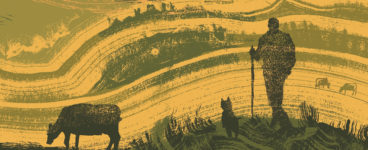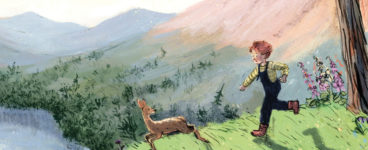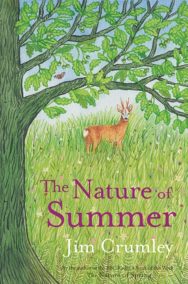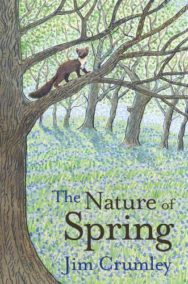‘It was a telling example of one of the bird’s character traits that distinguishes it from the golden eagle: it has no fear of humankind and its works, humankind’s settlements and humankind’s noise.’
Jim Crumley’s Nature quartet of books are some of the finest nature books in print. Here we celebrate the seasons of Spring and Summer. Firstly with St Kilda in the summer, then with a recollection of birds in spring.
Extracts taken from The Nature of Summer and The Nature of Spring
By Jim Crumley
Published by Saraband
St Kilda Summer 1988
Behind Boreray
It is black behind Boreray and small. All suns dance darkly here,
throw no shadows on rock this black.
Stac Lee is a black berg
its sunk seven-eighths beyond the scope of suns and me.
We who sail our puny daring under Stac an Armin
creep tinily by.
It all started in the early summer of 1988. I handed in my notice at the Edinburgh Evening News, where I had been working for eight years on the features desk, and at the invitation of publisher and landscape photographer Colin Baxter, I went to St Kilda, forty miles west of the Outer Hebrides, to write what would become my first book. Ian Nimmo, the editor of the Evening News at that time, and who had done much to encourage me to flex my writing muscles in his newspaper, gave me his blessing with the words “you must follow your star”. So began an adventure that changed my life utterly. I had been a journalist from the age of sixteen. At the age of forty, I became a full-time nature writer literally overnight (and halved my income at a stroke). It was a fast transition: the book was published three months later, on the day after I left the paper. The only copy of it I still possess is the one I gave to my mother, and which I had inscribed:
For Mum with much love from the author!
Jim
October 1988
She had been very critical of my decision to leave the Evening News (she was not the only one among my family and friends and ex-colleagues). But seeing that book and holding it in her hands and reading the inscription…all that changed everything: her opinion of the enterprise swung through 180 degrees from a headwind to a tailwind, and for the last five years of her life until her death in 1993, she became the champion of my cause.
My first book? I can no longer remember how it felt. Probably I walked on air for a few days, then I looked around, thought, “What’s next?” and started writing my second book. I thought that was how it was supposed to happen, and as no one has advised me differently, I have just kept on doing it ever since: forty books in thirty-two years. Still following my star, Ian. And thanks.
This book concludes a tetralogy of the seasons, and that life-redefining summer of 1988 seemed like a natural place to begin, the first of all my nature-writing summers, for all that it had been temporarily thwarted at the very first hurdle. On the day I was supposed to travel to Oban to join Colin Baxter for the sail to St Kilda aboard a two-masted schooner, I was floored by a violent gastric bug. So I went alone three weeks later by the rather less glamorous route of a flight to Benbecula, in the Outer Hebrides, and then the Army’s flat-bottomed landing-craft (the Army maintained a small base there at the time to service a cliff-top radar station). As one seasoned St Kilda veteran had counselled me: “She wallows like a drunken pig, that bitch.”
As it happened, she declined to wallow. The evening ocean was as benign as the Crinan Canal. HMS The Drunken Pig was sober and demure. I stared at the ocean, at its raft of islands astern and its absence of islands ahead. I slept. Then a voice gate-crashed a dream: “Anybody want to see St Kilda? It’s worth a look.”
Oh, yes please. I wanted to see St Kilda very much indeed, for was it not to be the passport to the rest of my life? My watch said 5a.m. I went up on deck and the Atlantic was barely astir and the sky was pink and St Kilda was purple. And the voice was right: it was worth a look.
It is that first look that I remember, the one utterly indelible souvenir that has survived those thirty-two intervening years intact. It was a cardboard cut-out, as two-dimensional as a stage set, and it floated upright among leisurely waves. And it was purple. Or rather it was purples. The nearest island, a dour little tea-cosy-shaped rock lump called Levenish, was the darkest purple. My particular sightline set it against the much larger island of Boreray, and Boreray not only stood more than 1,200 feet straight up out of the ocean, it was the silhouette of a sea monster, and it was paler purple, borderline lilac. Over the next two weeks of camping alone, I would see Borerary from many angles in many weathers and every hour of the day and the dusk and dawn, and including the view through a gauze of gannets from the un-horizontal deck of a yacht at very close quarters indeed; but not once did that extravagant portfolio I would amass ever threaten to dislodge from my mind’s eye that first of all my St Kildas on that first morning of all my nature-writing summers.
And Stac Lee was there too, a mere 600 feet high, but quite high enough for a lopsided parallelogram with no visible means of support, and that too was the paler shade of Boreray purple.
Then the boat dipped and I realised that parts of the superstructure were concealing parts of St Kilda, so I ran to the bow where wider oceanic miles lay unobscured. And there was Hirta, the main island, and there was the untidy sprawl of Dùn, Village Bay’s eccentric, wafer-thin breakwater, looking like a bar of Toblerone that had gone horribly wrong in the baking.
These set pieces of the St Kilda archipelago, so familiar to me (in outline, at least) from a few books, from other people’s photographs, from maps and film and drawings and paintings and word-of-mouth (it is astounding how many St Kilda veterans emerged like woodlice from under stones once the word of what I was doing leaked out) now made smithereens of my every preconception. While I stared and tried to respond in what I thought might be a suitably nature-writerly way to where I was and what I was seeing and what-the-hell-did-I-think-I-was-doing, by the way, something utterly new stole over me in the face of so much incomprehensible, volcanically tarnished age, and it was this: Though I turned very slowly through 360 degrees, I could not see any other land, in any direction, none at all. And these first moments became my all-purpose visual definition of St Kilda, the one I have carried in my mind ever since. And so primitive was the encounter, so elementally simple – one sea, one sky, one scatter of improbable rocks – that I might have been the first of all St Kilda voyagers, one of a tribe of nomadic herdsmen coming curiously up the margins of Europe, exchanging bemused glances and agreeing among themselves that surely here was nature’s last limit. For they would be accustomed to sailing where land was in sight, and on St Kilda, the only land very occasionally in sight (I would have one glimpse of a white-sanded Hebridean beach – Harris – in two weeks) is the land that you left forty miles behind to get here.
Time filters out the scents, the sounds, the touch and the taste of St Kilda on the air, and leaves only the sights (or the memory of some of them, at least), for every one of my fourteen days there was crammed with them. The freedom I was permitted to wander at will and alone meant that I crowded the days and some of the nights with everything all the time, occasionally retreating to my tent and my small portable typewriter to spill out the chaos of St Kilda into the manuscript of my first book. There was no time between the two, and no distance. And now, so much time has intervened, and so much distance; although I have returned often in my mind I have never returned in person. When I consider those first days of that first nature-writing summer (what a place and what astounding good fortune in which to begin), how could I ever improve on all that or add to or embellish it by going back? The simple passage of time, aided by memory’s tendency to edit selectively so that only the essential remnants stand forward in any kind of clarity from such a head-on collision with natural forces: all that has distilled down to a single time and place, the indispensable pure gold that sustains one traveller’s idea of that time, that place, my own personal St Kilda.
From The Nature of Spring:
Then, from the shore at Port Ramsay, just as sun-light began to enliven the visible world, a familiar shape emerged from a cursory scan of a wood across the water, an erect grey-brown slab that looked too big and too heavy for the comfort of the tree where it appeared to have been hung, like a sheet left out to dry. More careful consideration revealed that it was not hung but perched. Then it raised its head from its breast where it had been rearranging its feathers with an implement that looked like a cross between a sickle and a banana, and instantly became a sea eagle. And there it stood and there it stared and there it settled into prolonged stillness, looking as if it might spend the entire afternoon in that attitude. It was a telling example of one of the bird’s character traits that distinguishes it from the golden eagle: it has no fear of humankind and its works, humankind’s settlements and humankind’s noise. This one was in full view of Port Ramsay’s street of houses in the middle of the afternoon while the residents went about their business. The nearest house to the tree where the bird perched was about 200 yards. A collie barked. Two people worked on a boat. Three more chatted in a garden between house and shore, their voices carrying far over the quiet water. Two cars appeared from opposite directions at the one road junction, stopped there while the drivers conversed through open windows, engines running. The sea eagle feigned disinterest, but it is a safe bet that it took in everything.
Not one of the people I could see appeared to know that it was there; either that or its appearance in that tree was so familiar that it had become part of the furniture.
I mulled over the bird’s changing fortunes. One hundred years ago, almost to the day, the last of its kind in Scotland, in all Britain, was shot, and it was not as if no one knew that it was the last of its kind. Its extinction had been achieved deliberately. Now this, where a small island community appeared to be quite indifferent to the presence of one of the most astonishing birds in the northern hemisphere, casually perched on its doorstep. Mull across the water has even turned it into a tourist symbol.
A flashback barged into my mind. Twenty years before, I was in a small open boat motoring out from Hoonah, Alaska, a one-horse town in the Tongass National Forest. These were strange, eerie waters, lagoonishly glassy, lap-ping almost silently against shores of rock and mud, above which spruce and hemlock forest reached improbably far up mountains with no names, and extended for miles and miles. It takes the sudden appearance of a humpback whale a hundred yards off the port bow to inform a dislocated stranger that these waters are outposts of the Pacific Ocean too. As that dark-green shore glided past, tree by giant tree, we kept passing the erect, blond-headed totems of that country that are nesting bald eagles; they were as regular as milestones. My host, a part-Tlingit hunter and fishing guide called Floyd Petersen, cut the engine for a while so that we could talk more comfortably, with just the quiet accompaniment of the idling ocean. Suddenly a shrill, giddy voice poured a stream of molten silver down out of the trees, so that it bounced up at me off the water and hit me squarely between the eyes.
‘What the…?!’
‘Oh, that’s the eagle.’
Oh, that’s the eagle.
I found him with the binoculars, just as he was poised to let fly again. He threw his head back, opened his throat to the sky, and out poured the silver-tongued deluge again, and up it bounced again, and a chill rippled across my shoul-der blades. I thought of the opening bars of a concerto for wilderness. That image of an American bald eagle, head back and skirling is the one I carry in my head forever. Sea eagle and bald eagle are close biological kin, sharing the white tail if not the white head and the musicality. And the bald eagle is also unfazed by the proximity of humanity’s habitat. The first one I saw was flying across a hotel car park in downtown Juneau, Alaska’s state capital. But what the two tribes have in common most obviously is to stand erect in a conifer tree, sometimes for an entire afternoon. So what I saw when I scoured the woodland across the bay from Port Ramsay was a shape I remembered from a three-week expedition to Alaska for the BBC’s Natural History Unit, twenty years before.
The Nature of Summer and The Nature of Spring by Jim Crumley are published by Saraband, priced £9.99.
ALSO IN THIS ISSUE

 The Secret History of Here
The Secret History of Here
‘Perhaps there is co-operation as well as competition in the natural world.’

 Home of the Wild
Home of the Wild
‘I have had many animal companions in my life and all of them have touched me greatly, but the one t …














